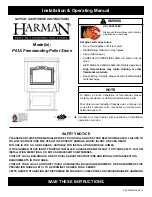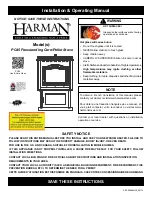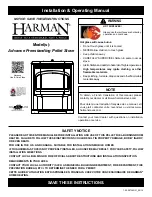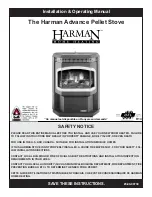
ENgLIsH
The heating of the room takes place:
a)
by means of radiation
: through the panoramic glass and the hot external surfaces of the stove, heat is radiated into the room.
b)
by conduction
: through radiators or convectors in the central heating system fed by the hot water produced by the Thermocooker
itself.
The thermocooker is supplied with registers for primary and secondary air and a thermostat with which the combustion air is regulated.
A - PRIMARY Air Control
(
Picture 6
).
With the lower control, the passage of primary air in the lower part of the cooker is regulated through the ash drawer and the grill in the
direction of the fuel. The primary air is necessary for the combustion process. The ash drawer must be emptied regularly, so that the ash
cannot block the primary air intake for combustion. The primary air also keeps the flame alive. The primary air control must be max. ¼
open during the combustion.
B - sECONDARY Air Control
(
Picture 6
).
This knob must be open (i.e. turned completely to the right), in particular for the combustion of wood (see Table). The secondary air,
passing between the double glass of the fire door, heats up and triggers the dual combustion, keeping the glass clean at the same time
(control open).
C - AUTOMATIC Thermostat
(
Picture6
)
The thermostat has the task of automatically increasing or decreasing combustion.
dependent on the position chosen, the thermostat will act on the valve which regulates the intake of air into the furnace, placed on the
back of the cooker. Turn it in a clockwise direction from 0 to 5 to make up the fire and in an anti-clockwise direction to reduce combustion.
as this is an extremely precise device, it is advisable to turn it carefully and never force the knob.
The control regulation necessary in order to obtain
nominal calorific
output is the following
(see Cap. TeCHniCaL daTa):
PRIMARY air
sECONDARY air
TERMOsTAT
TeRMosUpReMa CpT - dsa
1/4 open
open
3
iTaLY TeRMo - dsa
1/4 open
open
3
D - FLUE gAs Control
(
Picture 6
)
(Conversion from the cooker
HOTPLATE USE
–
OVEN USE
function to the cooker
HEATING
function)
in the central part of the instrument panel, there is the flue gas control, which can be recognised from its enamelled, labelled knob.
When the control is positioned to the
LEFT
(on the pan symbol), the combustion gases flow above and around the oven (oven function
–
HOTPLATE UsE – OVEN UsE
); when positioned to the
RIgHT
(on the water symbol), the gases flow near the boiler, increasing the
temperature evenly, favouring water heating inside it (cooker function
HEATINg UsE
).
E - IgNITION Control
(
Picture 6
).
on the front of the cooker, between the protective handrail and the flue gas control, there is the ignition control control lever, which can
be recognised by a chrome-plated knob.
This control must
only
be used to facilitate the ignition of fuel in the cooker. pull the lever outwards from the cooker (control open).
IMPORTANT
: during normal cooker operation, the control lever must remain completely inserted (pushed inwards on the cooker). in this
way avoiding excessive fuel consumption and poor thermocooker output (control closed).
To ignite the flame
follow the instructions below (see Cap. iGniTion) :
• open the ignition control to aid flue gas exhaust. position the control (any butterfly valve placed on the flue gas exhaust pipe must also
be opened).
• position the thermostat knob on position 5 (maximum opening).
• open the primary air control (placed on the ash tray).
• after having started the fire with small pieces of wood and waited until it is well lit, adjust the thermostat to the positions corresponding
to the desired heat (0÷5).
• Bring the flue gas control to the oven position.
• Close the ignition control (and any butterfly valve placed on the flue gas exhaust pipe must also be opened).
The control regulation
during the ignition phase
is the following :
PRIMARY air
sECONDARY air
TERMOsTAT
TeRMosUpReMa CpT - dsa
open
open
5
iTaLY TeRMo - dsa
open
open
5
THE FLUE
essential requirements for correct appliance operation:
• the internal section must preferably be circular;
• the appliance must be thermally insulated and impermeable and built with suitable materials which are resistant to heat,
combustion products and any condensation;
• there must be no narrowing and vertical passages with deviations must not be greater than 45°;
• if already used, it must be clean;
• all the sections of the flue gas duct must be accessible to inspection;
• inspection openings must be provided for cleaning.
• the technical data from the instruction manual must be respected;
if the flues are of a square or rectangular section, the internal edges must be rounded with a radius of not less than 20 mm.
for the rectangular section, the maximum ratio between the sides must be ≤ 1.5.
a section which is too small causes a reduction in draught. a minimum height of 4 m is advisable.
29
















































